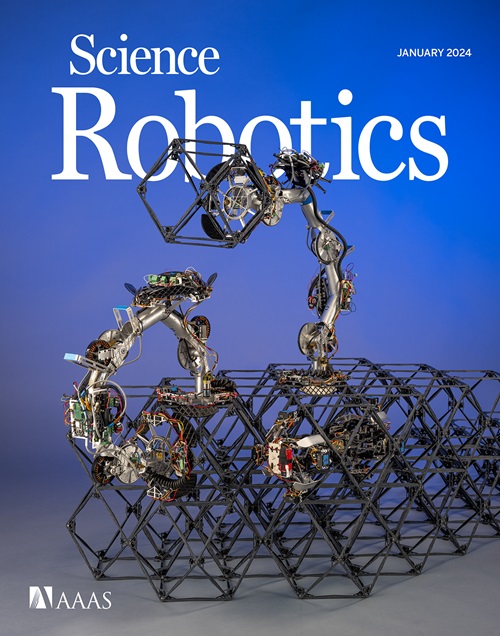利用快速锁定跟踪技术对昆虫进行高分辨率户外摄像
IF 26.1
1区 计算机科学
Q1 ROBOTICS
引用次数: 0
摘要
昆虫在全球生态、经济和健康领域发挥着重要作用,但我们对其行为的了解仍然有限。例如,蜜蜂利用视觉和微小的大脑寻找花朵并返回家园,但由于记录技术的限制,我们对它们如何完成这些令人印象深刻的任务的了解一直受到阻碍。在这里,我们介绍快速锁定(FLO)跟踪。这种方法可以移动图像传感器,使其始终聚焦在昆虫身上的反向反射标记上。利用准轴向红外照明,简单的图像处理就能在几毫秒内定位昆虫的传感器位置。如果再加上一个反馈系统来引导高倍率光学系统保持聚焦在昆虫身上,就可以在一个大区域内收集到高时空分辨率的轨迹。作为几种机器人系统的基础,我们展示了 FLO 是一种可与其他组件结合使用的多功能理念。我们证明,光路可以分割并用于记录高速视频。此外,通过在四旋翼无人机上安装 FLO 系统,我们跟踪了一只正在飞行的蜜蜂,并预计将在一公里的范围内跟踪野生昆虫。这种系统能够提供有关昆虫在自然环境中行为的更高分辨率信息,因此将有助于揭示昆虫在自然环境中使用的生物力学和神经伦理学机制。本文章由计算机程序翻译,如有差异,请以英文原文为准。
High-resolution outdoor videography of insects using Fast Lock-On tracking
Insects have important roles globally in ecology, economy, and health, yet our understanding of their behavior remains limited. Bees, for example, use vision and a tiny brain to find flowers and return home, but understanding how they perform these impressive tasks has been hampered by limitations in recording technology. Here, we present Fast Lock-On (FLO) tracking. This method moves an image sensor to remain focused on a retroreflective marker affixed to an insect. Using paraxial infrared illumination, simple image processing can localize the sensor location of the insect in a few milliseconds. When coupled with a feedback system to steer a high-magnification optical system to remain focused on the insect, a high–spatiotemporal resolution trajectory can be gathered over a large region. As the basis for several robotic systems, we show that FLO is a versatile idea that can be used in combination with other components. We demonstrate that the optical path can be split and used for recording high-speed video. Furthermore, by flying an FLO system on a quadcopter drone, we track a flying honey bee and anticipate tracking insects in the wild over kilometer scales. Such systems have the capability to provide higher-resolution information about insects behaving in natural environments and as such will be helpful in revealing the biomechanical and neuroethological mechanisms used by insects in natural settings.
求助全文
通过发布文献求助,成功后即可免费获取论文全文。
去求助
来源期刊

Science Robotics
Mathematics-Control and Optimization
CiteScore
30.60
自引率
2.80%
发文量
83
期刊介绍:
Science Robotics publishes original, peer-reviewed, science- or engineering-based research articles that advance the field of robotics. The journal also features editor-commissioned Reviews. An international team of academic editors holds Science Robotics articles to the same high-quality standard that is the hallmark of the Science family of journals.
Sub-topics include: actuators, advanced materials, artificial Intelligence, autonomous vehicles, bio-inspired design, exoskeletons, fabrication, field robotics, human-robot interaction, humanoids, industrial robotics, kinematics, machine learning, material science, medical technology, motion planning and control, micro- and nano-robotics, multi-robot control, sensors, service robotics, social and ethical issues, soft robotics, and space, planetary and undersea exploration.
 求助内容:
求助内容: 应助结果提醒方式:
应助结果提醒方式:


